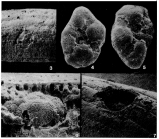
| Intro | | About | | Wiki | | Search traits | | Data explorer | | Literature | | Definitions | | Sources | | Webservices | | Statistics | | Feedback | | Editors | | Log in |
WoRMS taxon detailsPlanorbulinopsis Banner, 1971
722276 (urn:lsid:marinespecies.org:taxname:722276)
accepted
Genus
Planorbulinopsis parasita Banner, 1971 (type by original designation)
marine,
recent only
feminine
Banner, F. T. (1971). A new genus of the Planorbulinidae an endoparasite of another foraminifer. <em>Revista Española de Micropaleontología.</em> 3: 113-128.
page(s): p. 115 [details] Available for editors
Hayward, B.W.; Le Coze, F.; Vachard, D.; Gross, O. (2025). World Foraminifera Database. Planorbulinopsis Banner, 1971. Accessed through: World Register of Marine Species at: https://www.marinespecies.org/aphia.php?p=taxdetails&id=722276 on 2025-05-20
Date action by
Nomenclatureoriginal description
Banner, F. T. (1971). A new genus of the Planorbulinidae an endoparasite of another foraminifer. <em>Revista Española de Micropaleontología.</em> 3: 113-128.
page(s): p. 115 [details] Available for editors basis of record Loeblich, A. R.; Tappan, H. (1987). Foraminiferal Genera and their Classification. Van Nostrand Reinhold Company, New York. 970pp., available online at https://books.google.pt/books?id=n_BqCQAAQBAJ [details] Available for editors From editor or global species database
Diagnosis Test trochospiral in the early stage, about two whorls of inflated chambers separated by weakly depressed sutures, spiral side evolute, umbilical side involute and umbilicus open and deep, later chambers alternating in position with those of the preceding whorl, adjacent chambers of a single whorl are not in contact; wall calcareous, optically radial, coarsely perforate except for an imperforate peripheral band in the early stage, later chambers entirely perforate except immediately adjacent to the apertures and sutures, laminations added over the early test as successive chambers form and partly or completely close the perforations of earlier chambers on the spiral side; aperture single, interiomarginal, and umbilical in the early stage, with rimlike lip, later chambers with two arched rimmed apertures, one directed toward the umbilicus and the other on the periphery in opposition to the similar aperture of the adjacent adult chamber; parasitic on Alveolina, young individuals attach to the host by their umbilical side and burrow into the host's shell, the downward burrowing more rapid than radial growth so that the test becomes partly enclosed by the host test, and the latter is laterally tunnelled, probably by the pseudopodia of the parasite. Holocene; Coral Sea: Papua New Guinea. (Loeblich & Tappan, 1987, Foraminiferal Genera and Their Classification) [details]
|

